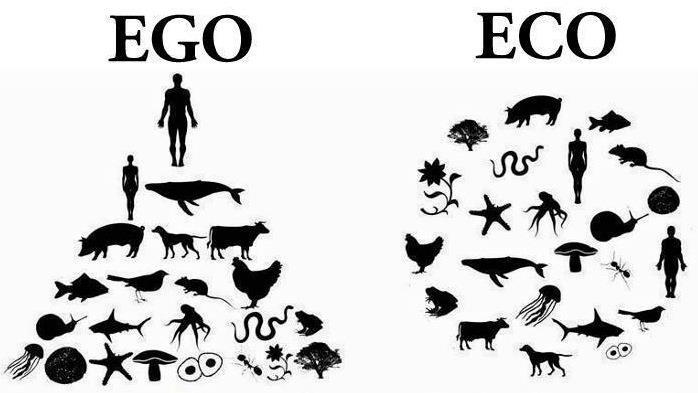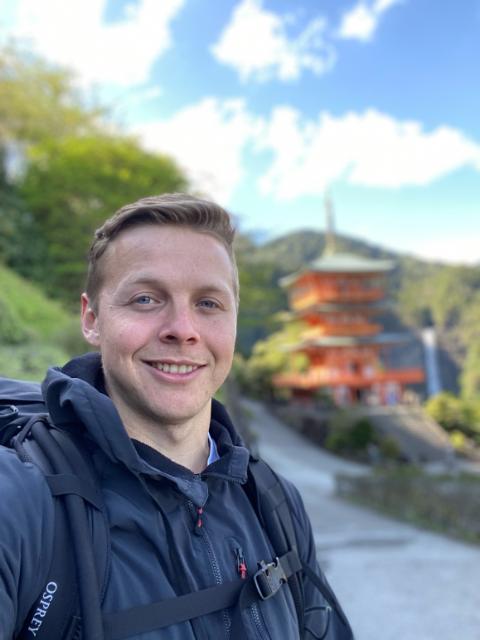The Conscious Collective Blog
The Conscious Collective Blog

What Is Deep Ecology? Looking Deeply into Our Oneness with Nature
“The deep ecology worldview is that the self exists as a combination of natural elements, and is in this sense, intimately a part of the natural world.”
The extinction of species is taking place every single day. Researchers estimate that every year over 20,000 species go extinct, and this rate is only accelerating. This is what is happening right now; it’s not something in the future. Scientists are referring to this rapid species die-off as the “sixth mass extinction event” to happen on planet Earth.
We live in a critical time in history. We are at a crossroads between an abundant life in harmony with the natural world, or the destruction of up to 95% of life on Earth—including human life. If we are to have any chance of survival, we need to change our behavior and the way that we impact the Earth—and fast. To change our behavior, however, we need to look deeply into who we are, what motivates our actions, and how we exist within the web of life. We need to realize that we are a part of the natural world, and that we depend on nature for everything.
This is the motivation behind an ecological movement known as “deep ecology.” Deep ecology also referred to as “ecosophy,” is an environmental philosophy and social movement based in the belief that humans must radically change their relationship to nature from one that values nature solely for its usefulness to human beings to one that recognizes that nature has an inherent value. Deep ecology offers a radical new perspective on the self, asserting that what we refer to as ourselves is not something isolated and separate from nature, but that the self is interconnected with and completely dependent upon the natural world.
What Is Deep Ecology?
Ecology is the branch of biology that deals with the relations of organisms to one another and to their physical surroundings. This is how it is defined by the Oxford dictionary, and it is essentially the study of the relationships between living organisms and their physical environment.
This is a wonderful thing to inquire into, but some ecologists have felt that the study of ecology has, like many other fields of study, become far too academic. They felt like we needed a new form of ecology, a field that not only studies nature and its relationships as passive observers, but something that challenged and transformed our very view of ourselves in relationship to nature. The idea being, that if we wish to really become students of the natural world, we cannot separate ourselves from it, but we must realize that we are a very part of the ecology that we are studying.
Deep ecologists seek to transform our perception of the self. The deep ecology worldview is that the self exists as a combination of natural elements, and is in this sense, intimately a part of the natural world. In this regard, deep ecology is the experience of a transformation in our understanding of ourselves in relation to our ecology.
It is not difficult to grasp this concept intellectually, that human beings are connected to and dependent upon nature. What is really needed, however, is for us to awaken to this understanding experientially—to feel it in our hearts and in our bones, not just to think it in our minds.
Why is this important? Because once we truly understand on a deep level that we are intrinsically a part of the natural world, we will seek to protect the natural world as it is the only way to protect ourselves and our own health. Deep ecologists have realized that unless we see nature as self, we won’t have a deep enough motivation to shift our behavior toward nature.
The idea of deep ecology, however, is not just that we should protect nature for self-preservation, but that nature has intrinsic value of its own, and should be cared for and protected for its own sake and for the many other species that it provides for.
Arne Naess, the Founder of the Deep Ecology Movement
The deep ecology philosophy was originated by a man named Arne Naess, a Norwegian philosopher born in 1912. Naess, influenced by the philosophical perspectives of Spinoza and Gandhi, coined the term “deep ecology” to express a vision of the world in which we protect the environment as a part of ourselves, never in opposition to humanity.
For more than fifty years, he sought to reshape the philosophical debate by drawing from and building on his previous work to outline a non-dualistic, non-anthropocentric philosophy of life. Ever since he coined the term deep ecology, Naess’s central concern has been to use philosophy and philosophical thinking to help humans overcome the ecological crisis and, ultimately, to restore the Earth to a state of rich and flourishing biological and cultural diversity. This drive, enthusiasm and dedication to life and the environment made Arne Naess into a leading figure in Norway, the ecology movement and international philosophy.

Deep Ecology Calls For A Transformation In Our Perception of Self
Human beings throughout history knew of their interconnectedness with nature as they were deeply immersed in the natural world. It is only in the last few centuries that humans have separated themselves from nature, both physically and psychologically.
Most of us now operate under the unconscious assumption that what we call “the self” is something that exists independent of the world around us. We feel that we exist “in here” somewhere in our bodies, and that the world is something which exists “out there.”
This perception, though held by most people living today, is not actually an accurate representation of who we are. We do not and cannot exist independent of our environment. You are made of the food you eat, the air you breathe, the water you drink, the sun that heats you and the planet, and so many other elements.
Yet, we do not tend to feel this on a visceral level. In fact, many of us often suffer deeply because we perceive ourselves to be disconnected and alienated from the rest of the world.
Because we feel ourselves to be separate from the world in which we live, we also tend to feel quite alone in this world.
Because we feel ourselves to be separate from one another, we often feel justified in judging, mistreating, and abusing other human beings and living creatures.
Because we feel that we are separate from Nature, we also feel it is okay to neglect Nature, to manipulate it, pollute it, and cause it harm.
Nearly all of the disasters of our time arise from this delusional belief that we have an existence independent of the world we live in. All of this misery, all of this destruction, all of this pain and suffering, is caused by our failure to realize that there is no separation in Nature, and that really, we are all one.
This is why great thinkers and philsophers like Arne Naess realized that in order to create positive and lasting environmental change, we don’t just need to reflect on our laws and policies, we need to get to the very root of the ecological crises—we need to transform our perception of ourselves as human beings, and evolve our definition of self to embrace the natural world.
Ancient Roots of Deep Ecology
While Naess coined the term “deep ecology” and sparked a new movement along with it, this idea of seeing human beings as interconnected parts of nature is not by any means a new philosophy. In fact, it is quite ancient.
We can find perhaps the oldest written document on deep ecology (though it wasn’t given this name at the time) in the ancient text of the Diamond Sutra. The Diamond Sutra is a primary text in the Mahayana Buddhist tradition (which includes the Ch’an or Zen school). Buddhism, among all world traditions, has focused most intently on questioning this notion of “self,” and no Buddhist text is more known for this than the Diamond Sutra.
Scholars believe the original text of the Diamond Sutra was written in India sometime in the 2nd century CE. Kumarajiva is believed to have made the first translation into Chinese in 401 CE, and the Kumarajiva text is the one most often translated into English.
Teachings of the Diamond Sutra
The Diamond Sutra urges its readers to throw away four notions:
The notion of self
The notion of human being
The notion of living beings
The notion of life span
This may seem strange at first glance. Why would we need to throw away these notions? To understand, we need to look deeply at what these notions mean, and at what “notions” are in themselves.
A “notion” is defined as: a conception or belief about something. We have a belief that we are a self, and with the birth of this notion we also birth the notion of not-self. But what is the self if not for all of the not-self elements?
When we think of ourselves as self, and other things in nature as not-self, we create a duality or separation that does not exist in reality. The tree, the sky, the sun—these are all not-self in terms of our notion of self. Without these elements, however, we could not exist. It is only because of not-self elements that what we call the self exists at all.
In the same way, we have a notion of human being, and with it, we create the idea of not-human beings. How can a human being exist without not-human beings? If there were no plant-beings, animal-beings, bacteria-beings, and so forth there could be no human beings.
We have the notion of living being, and think that other beings are not living. For example, we do not typically think of minerals or rocks as living beings. Yet, your own body contains many different minerals. The particles and electrons of the universe make up every single living-being. When we look deeply, we find that nothing can be excluded from life.
Lastly, the Diamond Sutra tells us to throw away the notion of a life span. We think that we have a life span, that we were born, and after birth, perhaps in 100 years or so if we are lucky, our life span will come to an end.
What happens when a life span ends? Where does this life go? Where did it come from? When we look deeply into anything we see that nothing simply ends, but that everything changes form. For example, if you were to burn a piece of paper, it’s life span wouldn’t end—it would transform into heat, smoke and ash. Similarly, it’s life span didn’t come from nothing, but transformed from a tree prior to being a piece of paper.
In the same way, you did not come from nothing. You came from your parents, who came from their parents and ancestors, who came from non-human being ancestors, all the way back to the Big Bang itself (if that is indeed the origin of the Universe).
The teaching of the Diamond Sutra urges us to challenge these preconceived notions, as though they may seem like undeniable truths to us, they are really only notions, and like any notion, they can keep us trapped and prevent us from seeing reality clearly.
Ultimately, what the is aimed at by throwing away these notions is the awakening of a very deep insight—the insight of interconnectedness.
Interconnectedness
Interconnectedness is something a bit deeper than just connection. Connection still implies duality—A is connected to B, but still separate. Interconnectedness is the realization that things only exist because of their relationship, and outside of this relationship they cannot exist.
We, as self, as human beings, as living beings, only exist in relationship to nature. There are countless relationships which make up our being—the relationships of atoms, particles, cells, tissues, organs, organ systems, plants, animals, and so much more.
We exist only because the Earth exists, the Earth exists only because the Sun exists, which exists only because the Universe itself exists. As naturalist John Muir said:
“When one tugs at a single thing in nature, he finds it attached to the rest of the world.”
Nothing exists in isolation, including you. What deep ecologists, including the deep ecology texts like the Diamond Sutra, invite us to do is realize that there is no separate self. You are not a separate self. Your self exists only in relationship to nature. Essentially, your self is nature.
This is the insight that is needed in order to transform our world. On a deep level, we need to shift our understanding of self to embrace all of life. Only then will self-preservation include the preservation of the natural world.
The Relationship Between Buddhism & Deep Ecology
As we can see, there are a lot of parallels between the philosophy of deep ecology and the teachings of Buddhism. Both are deep topics that invite us to question our very identity. Both also arise from looking deeply into nature.
The Sanskrit word for meditation, dhyana, has been translated by some to mean: to look deeply. Buddhists use meditation and mindfulness as a fundamental tool to awaken to this insight of our interconnectedness. When we quiet the mind, we are able to see and experience reality clearly, and in this way, awaken deeper insight within ourselves.
As you likely know, you do not have to be a Buddhist to practice meditation. We even have a course that can help you learn meditation from the comfort of your own home. We also have a free book that explores deeper this topic of our oneness.
Meditation helps us awaken to a deeper understanding of reality, and this shift in perception is really foundational for changing our behavior and the way we live with nature.
If we continue to operate under the false notion of being a separate self, we will continue to act according to that notion, and our planet, and ourselves, will continue to suffer because of it. We need to awaken from this illusion and realize that we are not a separate self, but that we are one with the whole of nature.
As Einstein, one of the greatest minds in history said:




